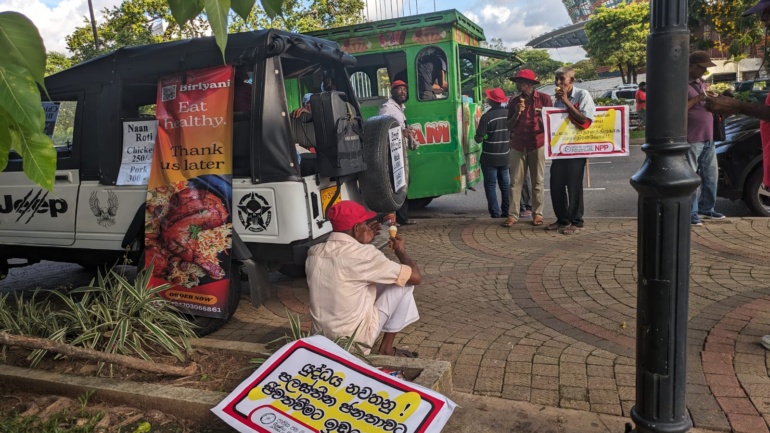Several incidents that happened this year indicate a resurgence of identity politics in the national political discourse. In the context of poverty and dispossession, hate politics may find a fertile breeding ground and may lead to an Ayodhya-like catastrophe which took place in 1990s India.
There was relative silence in the Sinhala and English mainstream media on issues concerning identity politics, due to the immediacy of the economic crisis. The Aragalaya also ran a counter-narrative downplaying ethnic divisions. The Rajapaksa regime, which had successfully cultivated the loyalty of a large Sinhala-Buddhist electorate in the post-war context, has lost its popularity and legitimacy significantly in the face of the crisis. Today, Sinhala Buddhist nationalist sentiment in the country appears to be politically leaderless. This provides a fertile ground for various factions, including the Rajapaksas, trying to consolidate their nationalist bases.
Meanwhile, President Ranil Wickremesinghe faces a number of dilemmas.
First, the Ranil-Rajapaksa alliance was formed in a context of many vulnerabilities and as a matter of political expediency. From what some SLPP (Pohottuwa) MPs are saying, Wickremesinghe was meant to ‘put things in order’ until Pohottuwa regained power. In his 10 months in office so far, President Wickremesinghe has been able to achieve some key milestones, including entering an IMF bailout agreement, relative control of fuel queues and shortages, and curbing inflation. Besides, delivering on these fronts, the powers accrued to the President by the Constitution are in his favour, as he can technically dissolve Parliament anytime since March this year. The Ranil-Rajapaksa alliance is an increasingly uneasy one.
Second, appealing to the nationalist sentiment has never been the forte of the President. Being an electorally weak partner in the ruling alliance, Wickremesinghe’s relevance weakens as the Pohottuwa gains strength. A mainstreaming of nationalist sentiment in the political discourse works in the favour of the Pohottuwa in this alliance.
Third, because economic reforms are being delivered in the context of resistance, such as protests against privatisation reforms and tax hikes, political leaders may find diversion into nationalist politics expedient. Using racism and inciting ethno-religious hatred is wrong and has caused immense loss and irreversible damage to individual lives and communities. Moreover, any attempt to allow divisive narratives to escalate in the political discourse can only backfire on those who choose not to act on it. As we discuss later in this article, India’s Congress government that implemented its 1992 IMF program was electorally penalised for allowing ethno-religious tensions to culminate in the demolition of the Babri Masjid in Ayodhya.
It is in this context that the recent spate of arrests (or threats of arrest) under the International Covenant on Civil and Political Rights (ICCPR) Act No. 56 of 2007, against speech allegedly inciting racial and religious tensions should be examined.
Recent media amplifications on alleged hate speech
On 27 May 2023, stand-up comedian Nathasha Edirisooriya was arrested by the Criminal Investigation Department (CID) on grounds of making disrespectful comments on Buddhism and other religions. The CID informed the Courts that they had arrested Edirisooriya following complaints lodged by the Commissioner of Buddhist Affairs and Buddhist monks against Edirisooriya. The police framed its surveillance of Edirisooriya on grounds that she was a person who had been in the Aragalaya.
Among the first responses to the video, which spread on social media, were from known subscribers to nationalist ideology. However, this escalated to more targeted vilification, hate speech, and character assassination. Following this, the discourse surrounding the video on media channels such as Derana and Hiru were of a nature that suggested the issue was being politically manipulated, to arouse majoritarian sentiment.
Invocation of the ICCPR to deal with alleged hate speech against Buddhism has been a common practice of the Sri Lankan state. Earlier this year, YouTuber Sepal Amarasinghe was arrested under the ICCPR for making derogatory remarks on the sacred Tooth Relic of the Lord Buddha. More recently, on 28 May, Venerable Rajangane Saddharathana Thero was arrested for making remarks which allegedly insulted Buddhism.
Another public figure who had recently attracted attention of a similar nature was Pastor Jerome Fernando. The Pastor made remarks which were disrespectful of Buddhism and other religions. There were calls from among the religious establishment and Buddhist nationalist groups for his arrest. However, the Pastor departed to Singapore a day before a flight ban from court was communicated to the authorities. This contrasts with how the CID had ‘informed’ the Bandaranaike International Airport, according to news, to detain Edirisooriya to record a statement before she could leave the country. The difference in how Pastor Jerome was able to escape arrest, compared to Sepal Amarasinghe, Nathasha Edirisooriya, and Venerable Rajangane Saddharathana Thero probably indicate that political links and elite patronage do make a difference.
Making sense of the complexities and political implications
The recent trend in arrests against those making alleged hate speech against Buddhism indicate that there is a strategic political campaign to use nationalist discourse to manipulate voters. Who is behind this campaign remains speculative so far. However, there are four possible ways to make sense of the present dynamics. They are by no means exclusive to one another:
First, racism and ethno-religious hate content is once again being mainstreamed in the interests of power politics at a time when nationalist sentiment seems to be leaderless. The interested groups can include the Rajapaksa quarters, political aspirants such as Wimal Weerawansa, and others who had favourable support of hardline ethno-religious groups, some other foreign group that wants to stir up relations among various communities and groups to make inroads into local affairs.
This comes against a backdrop of heightened ethno-religious tensions between Sinhala and Muslim communities, and Tamil and Muslim communities, which have led to violent outbreaks from time to time after the end of the war. What we see in the recent responses to some of these episodes, especially that of Nathasha Edirisooriya, is that Sinhala Buddhist sentiment is easily galvanised and has the risk of being used against an ethno-religious minority at a larger scale.
Second, the police use of ICCPR as the first response to any form of alleged hate speech or speech which harms ethno-religious harmony needs to be looked at in a few aspects. Adoption of the ICCPR Act was a precondition for Sri Lanka to qualify for the GSP+ scheme. In the nearly two decades of the ICCPR in Sri Lanka, no ‘suspect’ has been convicted. A law as strict as this, that bars bail, etc., when used indiscriminately, allows law enforcement establishment to punish people even without proper prosecution or conviction. Moreover, the ICCPR has never been used to safeguard minority ethnic or religious groups against hate speech.
Given the questionable and one-sided way in which this Act has been used, the Human Rights Commission of Sri Lanka (HRCSL) has issued a set of guidelines on Section 3 of the ICCPR Act. These guidelines make recommendations on how these strict laws need to be used. What policymakers must be concerned about is if the ICCPR Act of 2007 serves the purpose it was intended to serve, or if it is metamorphosing into a quasi-blasphemy law.
Third, paying close attention to the platforms on which these videos of alleged hate speech are circulated is important. In the context of the present political volatility, there are many emerging and competing aspirant political groupings. The YouTube channel on which the video of Nathasha Edirisooriya was hosted is called ‘Colombo Comedy Central’. It is linked to the popular YouTube channel SL VLOG, which is said to be led by Manju Nissanka.
His political ambitions seem clear, being the leader of Global Sri Lankan Congress and Singularity Sri Lanka. Nissanka has been a key supporter of the former President Gotabaya Rajapaksa and implicated in the MV X-Press Pearl bribe allegations. These complexities point to the fact that no easy reading of incidents of this nature is possible. In a press conference held on 30 May, SL VLOG distanced itself from the Nathasha Edirisooriya video, claiming that their channel should not be held responsible for the content it uploads and publishes.
Fourth, these episodes of hate speech may be used to deflect attention from the economic reforms agenda as it happens. This has political value for a government suffering from a democratic deficit, as it lacks the popular mandate since the Aragalaya last year, and various public approval ratings of the Government indicate its popular reception is very low. It is likely that the President’s hyper focus on economic reforms, which he sees as his main ticket to securing power and legitimacy, is coming at a cost of him totally neglecting developing social relations and dynamics which are brewing in the background.
As the President appears determined on single-mindedly bulldozing through a number of economic reforms, with minimal public consultation, his disconnect with the people on the ground and the growing conditions of poverty is evident. It is probably this very same disconnect which would lead the President to overlook the importance of acting promptly and decisively in face of the growing role of identity politics in the national arena once again. On Tuesday, the President ordered the creation of a police unit to probe groups threatening religious harmony. However, as dispossession and mass impoverishment is at unprecedented levels since independence, mobilising law enforcement measures alone will not be sufficient to prevent ethno-religious tensions triggering a catastrophe of national scale.
The dangers of this disconnect can be learnt by looking not too far away or far back. India’s experience of economic reforms in the early 1990s provide a lesson for Sri Lanka of today.
A flashback to Ayodhya
India launched an IMF reforms program in 1992 under the premiership of Narasimha Rao, whose legacy is stained with the burning of the Babri Masjid in Ayodhya in December 1992. This happened following an escalating spree of vilification and violence against Muslims. The polarisation that followed weakened ethnic relations and Rao’s minority government could do little to restore them. A few years passed as reforms were mulled over, but with a seriously damaged public image of the Congress government. The next election campaign, starting in late 1994 showed how the Congress Party went from state to state, addressing large audiences but losing its connection with the people. On the back of real poverty and Muslims being perceived as the enemy of the majority Hindus, it was easy for the BJP, the main hardcore Hindu nationalist political party to rise from the fringe of the political landscape to the centre stage in a bid to unify the Hindutva vote.
The present Government in Sri Lanka too is on a bid to implement difficult economic reforms and it is easy to lose sight of how ethno-religious tensions can get out of hand very quickly. As mass-scale poverty and dispossession remains threateningly high, hate politics may find a fertile breeding ground, that may lead to another Ayodhya-like catastrophe.
Harindra B Dassanayake and Rajni Gamage
This article was originally published in the DailyFT on 02 June 2023.
Image Copyright (c) 2023 Nazly Ahmed and made available under an Attribution-Noncommercial-Share Alike 2.0 license



